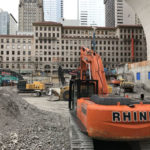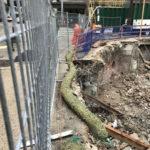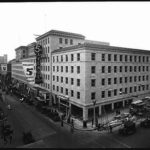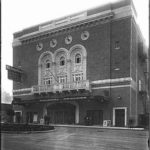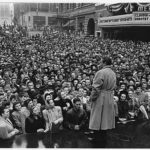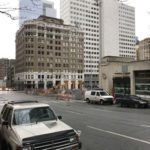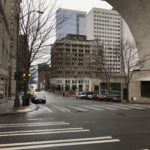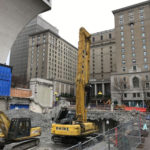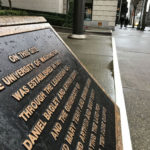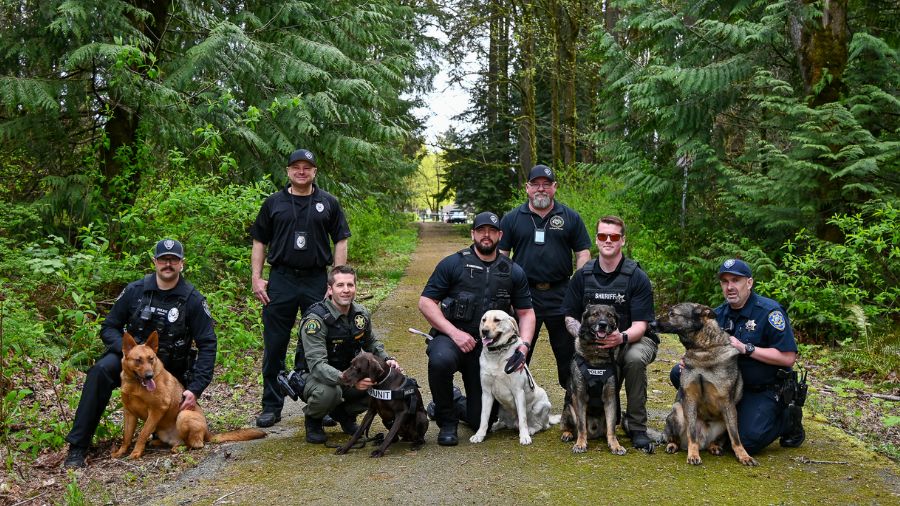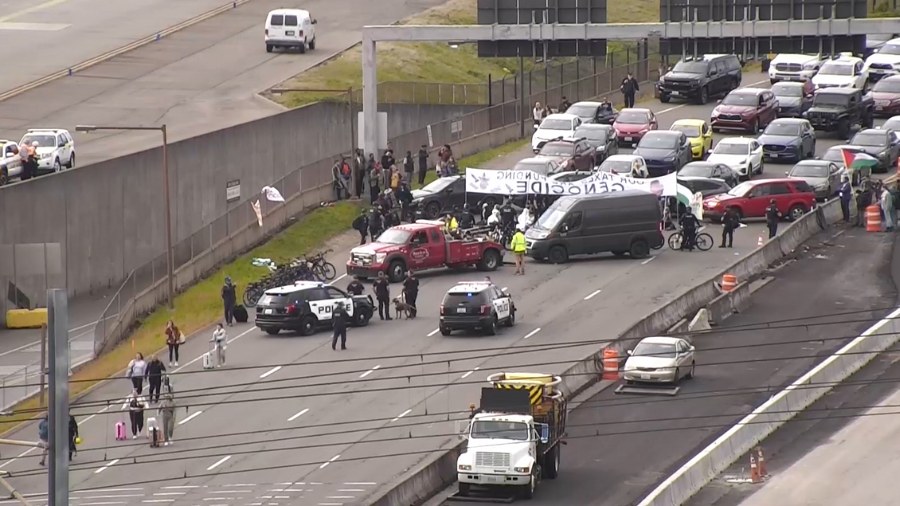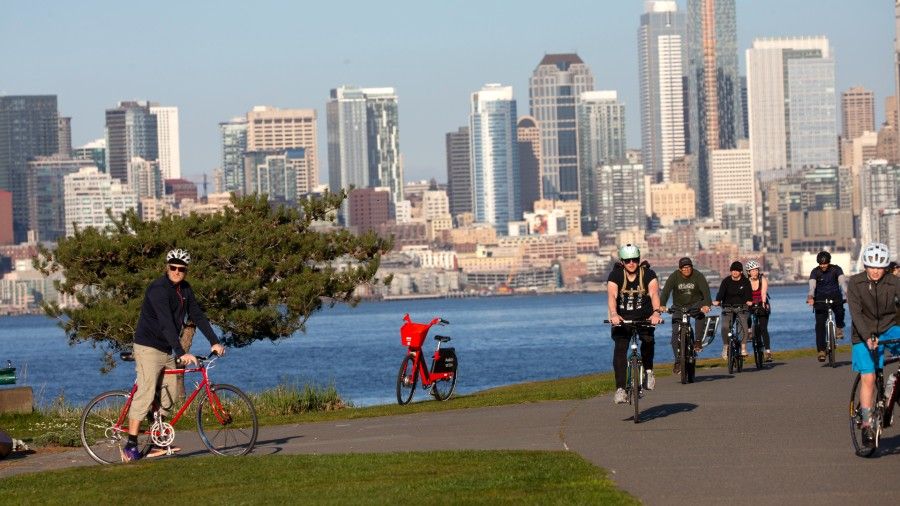Hidden layers of history uncovered by demolition of Rainier Square
Jan 24, 2018, 6:14 AM | Updated: 8:30 am
When the downtown Seattle shopping center from the 1970s known as Rainier Square was recently demolished, layers of the city’s history that haven’t been seen for decades were suddenly revealed.
But these pieces of the past will all soon disappear again.
Rainier Square was a low building that took up most of a city block. The block is part of a 10-acre parcel of land where the University of Washington was founded, and where the first campus building was constructed, in 1861. That original campus building, which sat roughly where the Olympic Hotel now stands, was a highly visible landmark for decades.
The distinctive Rainier Tower, designed by Seattle-born World Trade Center and Pacific Science Center architect Minoro Yamasaki, still sits on the southeast corner of the Rainier Square block, and the whole neighborhood is steeped in the city’s early history.
The parcel of land was donated by Seattle pioneer Arthur Denny, who with fellow pioneer Daniel Bagley, by some accounts, essentially hoodwinked the Territorial Legislature into siting the university here when Seattle was something of a remote outpost.
When UW expanded and moved to its present campus in 1895, it didn’t sell the land downtown. Instead, the valuable real estate was leased to a series of local companies that managed its development and paid the UW for the privilege of doing so.
The first company to really take the job seriously assumed the lease in 1907. This entity was called the Metropolitan Building Company, and the UW land downtown came to be known as the “Metropolitan Tract.” Incidentally, this is also where Seattle’s Stanley Cup-winning hockey team got its name.
A different approach
What made the Metropolitan Building Company’s approach to developing the land different than anything else going on in Seattle or, really, different from anything else going on in any city in the United States in the early 20th century, was the scope and scale of the vision.
Cascade Tunnel still going strong
“[The Metropolitan Building Company] employed a New York firm, Howells & Stokes, to do a master plan, and the master plan proposed what was called a ‘city within a city,’” said Jeffrey Karl Ochsner, professor at the University of Washington’s Department of Architecture.
Ochsner says that this comprehensive approach made sense because the Metropolitan Tract represented a huge piece of downtown, encompassing “parts of six blocks from Seneca to Union, crossing University, and from the alley between Third and Fourth to the alley between Fifth and Sixth.”
Had it been fully carried out, the Howells & Stokes master plan, Ochsner says, would’ve created a distinctive section of downtown Seattle unlike any other.
“The idea was that it would be developed incrementally,” Ochsner said. “Once it was fully developed, all the buildings would create a coherent appearance with consistent materials, consistent architectural style, [and] consistent scale.”
But financial and societal circumstances changed, and only a handful of office buildings developed in the Metropolitan Tract adhered to the master plan, Ochsner says, and only one of these – the Cobb Building, on the northwest corner of Fourth Avenue and University Street – is still standing. The first three, known as the White-Henry-Stuart Building, were controversially demolished in 1977 to make way for, you guessed it, Rainier Square.
Rainier Square: downtown vs the suburbs
In its day, says Jeffrey Karl Ochsner, Rainier Square was the ultimate expression of what was a common economic battle of those times: downtown versus the suburbs.
Lake Washington shipyard created Eastside’s first traffic
“Rainier Square really represents that era when people believed that the way for downtown to compete with the suburbs was to create the equivalent of a suburban shopping mall,” Ochsner said, with such amenities as indoor shops, atriums and underground tunnels to parking and other nearby buildings.
This idea, Ochsner says, has essentially been proven wrong.
“You don’t compete with the suburbs by imitating them, you compete by being what you are, and [offering] the kinds of places where pedestrians want to be, with sidewalk cafes” and other distinctly urban amenities, Ochsner said.
“Life is on the street,” Ochsner said. “It’s not hidden away in the interiors that turn their backs on the city.”
As for the history revealed by the demolition of Rainier Square – remember the White-Henry-Stuart Building that embodied the abandoned master plan? Turns out that when it was torn down 40 years ago, the row of buildings along Fourth Avenue wasn’t completely erased.
“As we’ve done the demolition and [are] starting to pick away at doing some excavation, what we’re running into are the old foundations and old basements and old faćades of the buildings that were there before the Rainier Square that we’ve known for the last 40 years,” said Greg Johnson, president of Wright Runstad and Company, the developer constructing the new building at the site. The new building, incidentally, will also be known as Rainier Square (both the square and the tower were originally named for Seattle’s long-gone Rainier Bank). Wright Runstad has an 80-year lease on the real estate from the University of Washington.
“It’s interesting,” Johnson said, of the phantom bricks and the sections of concrete now being unearthed. “It provides some challenges for our construction crew because it’s kind of unexpected, but I guess we should’ve expected to find old basements,” he said, chuckling.
On a recent visit, what appears to be the northwest corner of the foundation of the White-Henry-Stuart Building is clearly visible beneath the remaining sidewalk at the southeast corner of 4th Avenue and Union Street. The portion visible is a diagonal wall made of brick, roughly 15 feet wide and 10 feet from top to bottom. In looking at old photographs of the White-Henry-Stuart Building, the piece revealed beneath the sidewalk appears to match up exactly with what was the front door or threshold of the original 1908 structure.
Greg Johnson says that all these old concrete and brick pieces will be ground up and reused in the new Rainier Square that his company is building. The new Rainier Square is a 58-story tower with a wide base. The design, which some have likened to a giant boot, maximizes the footprint – or “bootprint” – and is intended to complement the narrow-base design of the adjacent Rainier Tower.
The new building also takes away all of the other pieces of hidden history that were uncovered when Rainier Square was demolished.
This other “hidden history” isn’t made of concrete or brick, and it can’t be ground up and reused. This hidden history is the incredible – and very temporary – scenic views of downtown Seattle, and especially the Metropolitan Tract, that are visible now and only for the next few months.
Because the 1970s Rainier Square is now gone and the lot surrounding the Rainier Tower is currently empty, the four city blocks bordering the site – Union Street between Fourth Avenue and Fifth Avenue; University Street between Fourth Avenue and Fifth Avenue; Fourth Avenue between Union Street and University Street; and Fifth Avenue between Union Street and University Street – have all been opened up to offer views not seen for decades, if ever.
For example, the front or west side of the 1925 Skinner Building, home to the Fifth Avenue Theatre, can now be seen, in its entirety, from the corner of Fourth Avenue and Union Street. The block-long building is now visible from top to bottom, from side to side and, most importantly, from a far enough distance away to be better appreciated than ever before.
And similar views are to be had by pedestrians and occupants of vehicles on the roadways and sidewalks of all four blocks surrounding Rainier Square.
As the accompanying photo gallery shows, observers with even just a few minutes to spare will find similar long-unseen or never-before-seen views of the Cobb Building at Fourth Avenue and University Street; the Great Northern Railway Building (now Men’s Wearhouse) at Fourth Avenue and Union Street; the 1411 Fourth Avenue Building, also at Fourth Avenue and Union Street; and the north side of the Olympic Hotel on University Street between Fourth Avenue and Fifth Avenue.
Heritage of Rainier Square ‘not lost on us’
Greg Johnson of Wright Runstad is clearly aware of all this history surrounding Rainier Square and his company’s construction project. He’s also philosophical about the changes being wrought within the Metropolitan Tract, now and over the decades.
“The heritage of that location is not lost on us, and [with] each generation where there’s been a renewal of property somewhere on that University Tract, you’ve ended up with different architectural styles,” Johnson said. “One of the things we thought a lot about was how do we, in our stewardship of that location, how do we contribute in a way that’s going to support or enhance its timeless nature.”
Johnson also says those rare views currently available in the blocks around the project won’t be here for long. Construction crews should be several floors above street level by late this year, and at least partially blocking views of the old buildings, once again, even sooner than that.
As for the “city within a city” described in the original Metropolitan Tract master plan, Jeffrey Karl Ochsner says it never even came close to being fully realized. He also says that in recent decades, while the area hasn’t had a consistent and coherent look and feel, it has instead offered its own distinctive experience to anyone willing to take the time to look.
“It really is a series of layers of different periods,” Ochsner said. “You could ‘read’ the sequential history in the buildings if you knew how to do so.”
“If you think of it, even today, the buildings are a timeline,” Ochsner continued. “With the Cobb Building from 1910, the Skinner Building from 1926, the Olympic Hotel from the 1920s, the Washington Building, now Puget Sound Plaza, from the 1950s, the IBM Building from the 1960s, and Rainier Square from the 1970s.”
“I mean, you can see it as a series of layers of different intentions,” Ochsner said.


